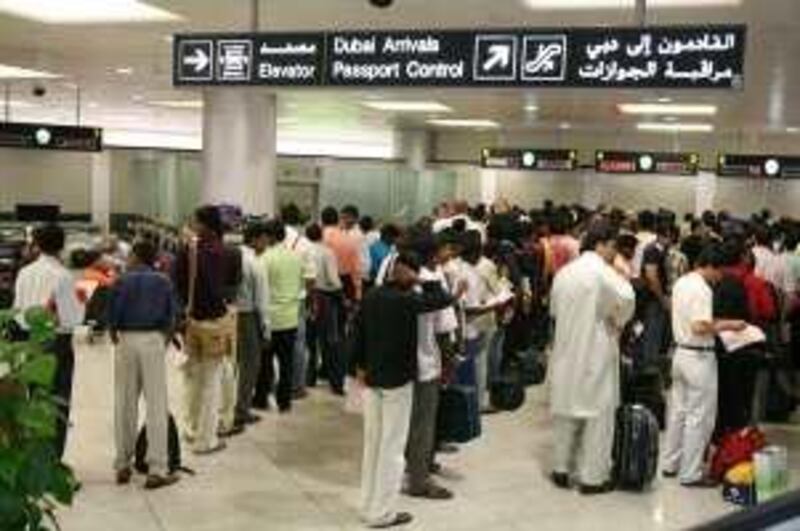DUBAI // Air traffic control in Dubai requires an urgent overhaul as the skies become dangerously congested, airport and airline heads say as they prepare for significant growth in flight and passenger numbers over the next 15 years.
Dubai Airports, which operates Dubai International, the fourth busiest in the world, and the upcoming US$8 billion (Dh29.4bn) Al Maktoum International in Jebel Ali, is preparing for a five-fold increase in passenger traffic by 2025 as airlines expand their fleets and routes and the budget carrier flydubai begins regular service, starting tomorrow. It expects the 12 per cent per annum growth that has seen passenger numbers rise from 10 million to 38 million a year since 1999, to be sustained with increased capacity provided by the five-runway Al Maktoum International airport, which is scheduled to open in phases between mid-2010 and the 2020s.
While Dubai Airports acknowledges that the completion of what will be the world's largest airport is a significant challenge, Paul Griffiths, its chief executive, has cited a reform of air traffic control in the region as the key to making the target a reality. "In the last decade Dubai has changed from a transit stop to a leading international hub," he said, "and this has led to an increase in airport capacity and the volume of air traffic.
"The introduction of flydubai, a high density and high frequency budget carrier, is set to increase this even more, and we are fast approaching a point where there will not be enough airspace. "Because of the number of no-fly zones and restrictions on commercial flights in the region, all air traffic is forced into narrow corridors that are becoming increasingly congested." Mr Griffiths added: "In Dubai there are currently 53 plane movements an hour. This will increase to 169 when Al Maktoum International airport is fully operational. When this is placed in the regional context of other expanding airports in the Gulf it is evident that air traffic control has to be reformed."
A factor contributing to the congestion is that half of the UAE is designated as military airspace and that planes cannot fly over the empty quarter because of a lack of surveillance in the area. "In Europe they have a system where commercial planes fly in military airspace, and their movements are closely monitored," Mr Griffiths said. "The introduction of such a system in the Middle East would free up a lot of airspace."
The plea was echoed by Emirates Airline, one of the fastest-expanding airlines in the world. Bob Everest, the vice president for flight operations support at the airline, said a UAE airspace review was desperately needed, especially as air traffic was expected to double in the next 15 years. "We need to implement a Performance Based Navigation (PBN) system in the region," he said. "Not only will this ease air traffic by opening up new routes but it will also bring much needed predictability for pilots and air-traffic controllers. This will increase safety levels and also lead to a reduction in fuel use and CO2 emissions."
PBN systems provide a safer and more efficient air traffic control by closer monitoring of aircraft and an alerts mechanism whereby pilots are notified of any changes in course. A PBN system also requires aircraft to comply with performance specifications, including rigorous safety checks, prior to the path being flown. Such a system enables aircraft to fly closer and with greater frequency within air corridors. Earlier this month the Abu Dhabi International Airport took the first step in implementing PBN by adopting a new system called RNAV-1, which tracks an aircraft's position with greater precision enabling corridors to be shrunk from 16km to 3km wide. This provides an opportunity to create new corridors.
There is a significant variance in the landing patterns at UAE airports, causing many planes to be caught in a holding pattern, wasting fuel and causing delays. A PBN system would help to rationalise such routes and therefore reduce traffic. The increase in scheduled flights is anticipated to see UAE airspace handle 1.4 million flights a year by 2020, making the more effective use of airspace a priority.
"The Al Maktoum International airport will enable increased capacity, but the question has to asked whether air space restrictions will prevent it from reaching its potential," Mr Everest said. Local airlines and Dubai Airports have in the past called for a GCC-wide traffic control system to better manage the crush of new flights. While conceding that the situation needs an urgent answer, officials at the General Civil Aviation Authority, have said that such a system would not ease Dubai's congested airspace.
Instead, the regulator said, the crowded airspace would be better managed using such upgraded technology as the PBN system.
tbrooks@thenational.ae
* With additional reporting by Ivan Gale






